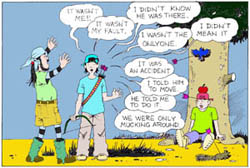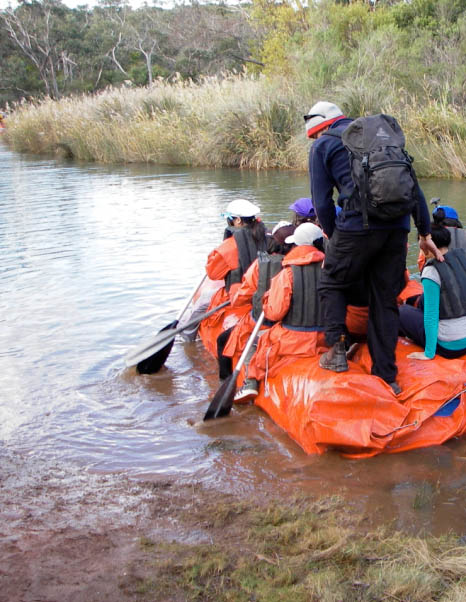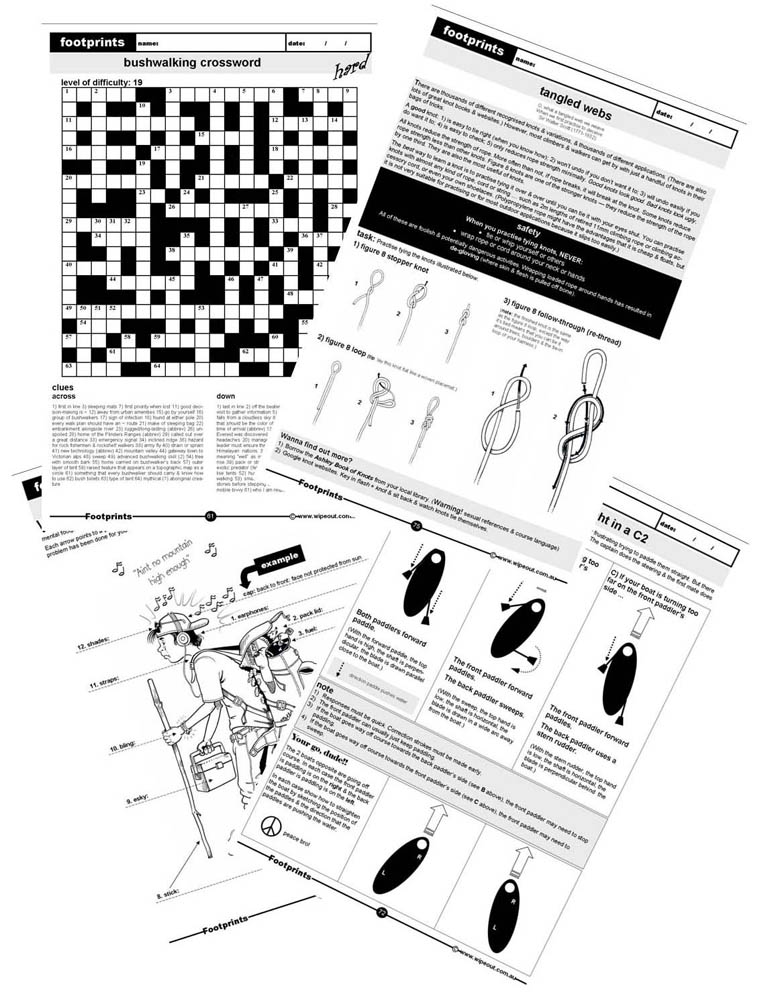wipeout.com.au is the website of Wipeout Publications. Wipeout Publications is an Australian-owned publishing shed which was established in 2003 and sells:
Footprints outdoor education workbook and
The colonisation of Australia, as told by a nine-year-old in 1960.
 |
Warning: we don't have all the answers!
| 1 | traditional owners | 31 | psychology of adventure | 61 | bushwalking crossword hard |
| 2 | personal safety | 32 | weather 101 | 62 | to build a fire |
| 3 | personal health & hygiene | 33 | weather 201 | 63 | how to stay warm & |
| 4 | personal health & fitness | 34 | storm chasers 1 | 64 | getting ready for the snow |
| 5 | personal well-being | 35 | storm chasers 2 | 65 | snow safety |
| 6 | river hazards | 36 | CSI weather | 66 | zen & the noble art of chook |
| 7 | surf hazards | 37 | Huey weather & surf | 67 | zen & the art of ripping up |
| 8 | water rescue | 38 | catching waves | 68 | fully cool crossword |
| 9 | swim & survival | 39 | where waves come from | 69 | surfing the zambezi |
| 10 | hypothermia | 40 | breaks & boards | 70 | paddling lexicon |
| 11 | hyperthermia | 41 | zen & the art of | 71 | zen & the art of paddling a |
| 12 | dehydration | 42 | map reading 101 | 72 | how to go straight in |
| 13 | DRABCD | 43 | map reading 201 | 73 | river race |
| 14 | bleeds | 44 | designing your own island | 74 | care of climbing equipment |
| 15 | head & spinal injuries | 45 | walk this way | 75 | tangled webs |
| 16 | burns & scalds | 46 | how to cook with a | 76 | climbing calls |
| 17 | bites & stings | 47 | how not to fry yourself | 77 | safety around rockfaces |
| 18 | blisters & sprains | 48 | zen & the art of cooking in | 78 | underwater dreaming |
| 19 | 1st aid kits | 49 | gourmet bush tucker | 79 | zen & the art of snorkelling |
| 20 | Phyllis story | 50 | tarpology 101 | 80 | bicycle checklist |
| 21 | blood on poa | 51 | feng shui & tent sites | 81 | crash course in cycling |
| 22 | australian landscape | 52 | outdoor makeover | 82 | outback safety |
| 23 | feral peril | 53 | how to shed those unwanted | 83 | outback survival |
| 24 | possum hypothetical | 54 | planning a clothing & equipment list | 84 | yin & yang of caving |
| 25 | orchid killing fields | 55 | how coool is davo | 85 | job search |
| 26 | global warming | 56 | kaptain karabiner to the rescue | 86 | puzzles 4 dummies |
| 27 | how green are you | 57 | kaptain karabiner to the rescue | 87 | advanced puzzles 4 dummies |
| 28 | take nothing but photographs | 58 | lost procedure | 88 | trivial disputes |
| 29 | leave no trace | 59 | observing the night sky | 89 | surviving the death zone |
| 30 | natural highs | 60 | bushwalking crossword easy | 90 | australian birds & butterflies |
This sample lesson plan is based on worksheet #8 ("Water rescue").
Steps
- Use the worksheet as a guide to identifying specific learning outcomes.
- Take students to a river — or bring the river to them … in the form of images (e.g. slides, power point, blackboard, expansive hand gestures, etc.).
- As a group, identify as many hazards to river users as you can. In each case, make the link between the hazard & the potential injury. Ask students how these hazards might vary according to varying weather conditions (e.g. flooding).
- Ask students to rank the hazards in terms of the most probable cause of injury.
- Ask students to rank the injuries from least serious to most serious.
- Ask students to demonstrate the international distress signal, & explain when it is appropriate/important to use it.
- Discuss the way in which alcohol consumption & other risk-taking behaviour increase risk in outdoor (& especially aquatic) environments.
- Discuss the effects of environmental factors such as water temperature, windchill & solar radiation.
- Show students several different forms of flotation (e.g. PFD, wetsuit, eskie, etc.) & elicit other examples.
- Set up or simply describe a rescue scenario where a conscious breathing person is likely to require an ambulance (e.g. in the case of a suspected fracture). Ask volunteers from within the class to outline a possible rescue sequence.
- Quiz students about proper procedure for making an emergency telephone call.
- Discuss the importance of rescuers not endangering themselves, & discuss ways in which the injured person might be removed from the water without the rescuer immediately jumping in. (Use the Royal Lifesaving Society’s rescue sequence as a guide.)
- Discuss ways to minimise risk during aquatic-based recreational activities in terms of remembering simple safety rules. (For example, never swim while under the influence of alcohol.)
- Ask students to complete worksheet #4 in class or at home.
- Correct answers in class.

This section is designed to support the Footprints outdoor education workbook with suggested answers to questions &/or solutions to problems.
Answers & solutions provided here should be seen as a guide, not Gospel. Wipeout encourages teachers & students to critically consider every proposition.
If we have made an obvious or apparent mistake, email us at This email address is being protected from spambots. You need JavaScript enabled to view it. so the mistake can be rectified.
Wipeout publications operates email back-up for anyone who has purchased Footprints. If you have other general or specific queries regarding Footprints, email us at This email address is being protected from spambots. You need JavaScript enabled to view it. & we will do our very best to reply as soon as we have returned to civilisation.
To check answers for specific worksheets, click on the respective link below.
Outdoor education is as much art as science. That means it is just as likely that there will be a range of more or less appropriate answers as one correct verifiable answer. Time & space are limitations that result in over-simplification of suggested answers.
Every attempt has been made to ensure that information provided in Footprints & these answers is reliable, accurate & relevant. We hope that both workbook & our on-line support for it are useful resources for outdoor educators & a fun way of learning for kids.

